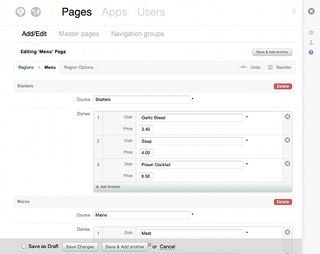Could this tiny CMS make your life easier?
It’s inexpensive and easy to use, and so sites will actually get updated, say its creators. We check out what Perch 2.3 has to offer.
Content management system Perch has been upgraded to version 2.3. The update adds 'repeaters' (repeating items within repeating items), a revamped login screen, enhancements to roles and privileges, and improvements regarding responsive web design. Licences remain one-off per site and are priced at $79.
Four years after its launch, Perch now powers over 24,000 sites. Speaking to Creative Bloq, developers were quick to sing its praises. Web designer Graham Street said he'd previously spent a decade wrestling with CMS systems that forced a framework or structure when building sites for clients who wanted to update content: "But when we discovered Perch, we found it enabled us to create sites how we wanted to. It didn't get in the way of the design and build process. Also, our clients love using it and rarely require more than a 10-minute phone call to get started."
Marc Sanders, digital lead at Third Floor Design said Perch was used to manage content on the Posterista marketing site: "We love the product because it allows us to craft and code with no restraints, and we can add additional functionality with ease." Street added this is also the case for existing sites: "This year alone, we used Perch to retrofit a CMS into three existing websites. We also used it for five new ones. We can't now conceive building a site without it!"

A simple system
According to Perch co-creator Drew McLellan, this type of response from jobbing web designers and developers is no accident: "Perch is a deliberately simple system that tries to meet the needs of most bread-and-butter website builds." Eschewing what McLellan refers to as "fancy 'enterprisey' features like publishing workflows", he said the CMS is centred on the principle that the web designer puts the site together, and the client can then keep it updated with fresh content. "We try to think about functionality from a human point of view, rather than from the technology, and implement simple features that get the job done with less complexity".
Perch therefore takes a different approach from its contemporaries. There's no baked-in HTML for designers to fight with - instead, you get a simple template system utilising HTML-style tags. For clients, the interface is based around a site's pages, making it obvious where to find content and add new pages.
"With years of working on client projects, we found it's not reasonable to expect a user to understand complex abstractions like putting a post in a specific category to update a page - a common model in blog systems. So we keep things simple and unabstracted, where possible," explained McLellan.

Further assistance for both designer and client comes in the form of Perch utilising structured content: "Instead of a big WYSIWYG box to edit everything, you can break the content down into structured fields, which Perch collects individually and displays through your template. For the client, this makes adding content really simple. For designers, it enables templates to be redesigned, and content can be reused in different formats throughout the site."
Get top Black Friday deals sent straight to your inbox: Sign up now!
We curate the best offers on creative kit and give our expert recommendations to save you time this Black Friday. Upgrade your setup for less with Creative Bloq.
Keeping things current
To further help designers and clients alike, Perch 2.3 adds a much-requested feature: repeating items within repeating items. These new 'repeaters' enable you to pick sections of a template that can be repeated as many times as needed. You can also place a limit on the number of items.
This kind of update, responding to user demand, is typical of Perch. McLellan said: "Strange as it may sound, we don't have a formal roadmap - just a vision of what Perch should and shouldn't be. The most important thing is to listen to our customers and hear what they need." Too many advance plans, he argued, can result in wasted effort.
McLellan said Perch also responds to global changes in the industry: "We've made sure Perch makes it easy to build responsive sites. We presume mark-up will be HTML5, unless you state otherwise. Perch will compile your SASS into CSS, if you want. It can create hiDPI images when clients upload photos, and it even supports Compressive Images and both of the new proposed responsive image formats. We often hear from people who can't use modern techniques because their CMS doesn't support it. We don't want Perch to be like that."

This sense of focus - on designers and the industry - in part explains how Perch has thrived during its first four years. "It's not uncommon to see CMS projects spiral out of all control when a client has a shopping list of requirements," added McLellan. "You can spend hundreds of thousands - millions - on enterprise software that gets barely used and is replaced two years later. Perch is the opposite of that. It's an inexpensive solution that provides the common functionality needed to manage most sites, and it aims to be easy enough to use that the site will actually get updated!"
Words: Craig Grannell
Liked this? Read these!
- Underrated web design tools to check out today!
- Pro tips for mobile website design
- Great examples of parallax scrolling websites
Do you have a favourite CMS? Tell us about it in the comments!

Thank you for reading 5 articles this month* Join now for unlimited access
Enjoy your first month for just £1 / $1 / €1
*Read 5 free articles per month without a subscription

Join now for unlimited access
Try first month for just £1 / $1 / €1
The Creative Bloq team is made up of a group of design fans, and has changed and evolved since Creative Bloq began back in 2012. The current website team consists of eight full-time members of staff: Editor Georgia Coggan, Deputy Editor Rosie Hilder, Ecommerce Editor Beren Neale, Senior News Editor Daniel Piper, Editor, Digital Art and 3D Ian Dean, Tech Reviews Editor Erlingur Einarsson and Ecommerce Writer Beth Nicholls and Staff Writer Natalie Fear, as well as a roster of freelancers from around the world. The 3D World and ImagineFX magazine teams also pitch in, ensuring that content from 3D World and ImagineFX is represented on Creative Bloq.




